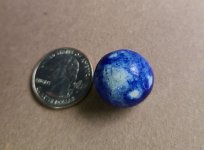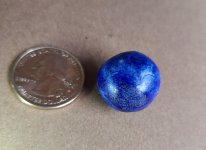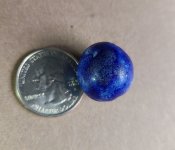After doing some research online I have to assume it is a Bennington marble, but I am not experienced in the topic and there seem to be some inconsistencies between this item and a classic blue Bennington.
I found this on the side of a hill while backpacking through a burnpatch in Northern New Mexico. I do not know how recently the wildfire had burned the area, but it was partly on the surface of the ground. It was a fair distance from any trail or road.
It does not have the distinct Bennington 'eyes'. There is only 1 faint semicircle which I see which could be the remains of an eye. (look at the right side of the 2nd pic)
It also has unusual coloring from what I have seen online. The blue dye seems uncommonly dark and uneven. Especially in one large dark shape that roughly resembles an X. (4th pic)
The largest white spot pictured in the 2nd photo has a couple tiny grooves/cuts which makes it less smooth than the rest of the marble. I assume this is just wear from use.
It is also worth mentioning that it is far from perfectly round. This may be because it had been left outside for so long, but most Benningtons I have seen online are more round. Which leads me to believe it was made by hand and not with the normal machinery.
Does anyone know if there is anything else this could be? Or is it just a poorly kept Bennington?




I found this on the side of a hill while backpacking through a burnpatch in Northern New Mexico. I do not know how recently the wildfire had burned the area, but it was partly on the surface of the ground. It was a fair distance from any trail or road.
It does not have the distinct Bennington 'eyes'. There is only 1 faint semicircle which I see which could be the remains of an eye. (look at the right side of the 2nd pic)
It also has unusual coloring from what I have seen online. The blue dye seems uncommonly dark and uneven. Especially in one large dark shape that roughly resembles an X. (4th pic)
The largest white spot pictured in the 2nd photo has a couple tiny grooves/cuts which makes it less smooth than the rest of the marble. I assume this is just wear from use.
It is also worth mentioning that it is far from perfectly round. This may be because it had been left outside for so long, but most Benningtons I have seen online are more round. Which leads me to believe it was made by hand and not with the normal machinery.
Does anyone know if there is anything else this could be? Or is it just a poorly kept Bennington?




Last edited:







